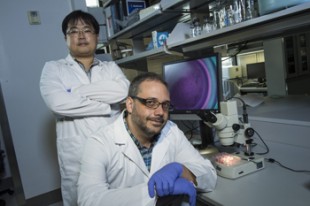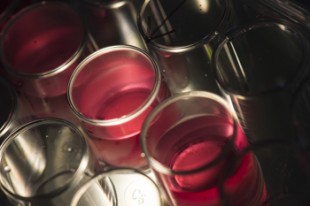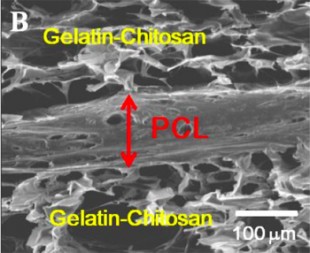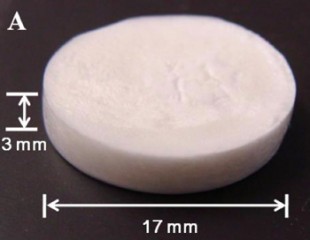Rice, Texas Children’s team creates biocompatible patch to heal infants with birth defects
A painstaking effort to create a biocompatible patch to heal infant hearts is paying off at Rice University and Texas Children’s Hospital.
The proof is in a petri dish in Jeffrey Jacot’s lab, where a small slab of gelatinous material beats with the rhythm of a living heart.
Jacot, lead author Seokwon Pok, a postdoctoral researcher at Rice, and their tissue-engineering colleagues have published the results of years of effort to produce a material called a bioscaffold that could be sutured into the hearts of infants suffering from birth defects. The scaffold, seeded with living cardiac cells, is designed to support the growth of healthy new tissue. Over time, it would degrade and leave a repaired heart.
The research was detailed in the Elsevier journal Acta Biomaterialia.

Jeffrey Jacot, seated, and Seokwon Pok of Rice University and Texas Children's Hospital have created a bioscaffold with the potential to heal infants with birth defects. The biocompatible patch would biodegrade over time and leave behind only healthy tissue. Photo by Jeff Fitlow
Patches used now to repair congenital heart defects are made of synthetic fabrics or are taken from cows or from the patient’s own body. About one in 125 babies born in the United States suffers such a defect; three to six of every 10,000 have what’s known as a defect called Tetralogy of Fallot, a cause of “blue baby syndrome” that requires the surgical placement of a patch across the heart’s right ventricular outflow tract.
Current strategies work well until the patches, which do not grow with the patient, need to be replaced, said Jacot, an assistant professor of bioengineering at Rice University, director of the Pediatric Cardiac Bioengineering Laboratory at the Congenital Heart Surgery Service at Texas Children’s Hospital and an adjunct professor at Baylor College of Medicine.
“None of those patches are alive,” Jacot said, including the biologically derived patches that are “more like a plastic” and are not incorporated into the heart tissue.

Biocompatible patches to repair congenital heart defects are under development at Rice University and Texas Children's Hospital. The patches are seeded with live heart cells and, after incubation, beat under their own power. Photo by Jeff Fitlow
“They’re in a muscular area in the heart that’s important for contraction and, more so, for electrical conduction,” he said. “Electrical signals have to go around this area of dead tissue. And having dead tissue means the heart produces less force, so it’s not surprising that children with these types of repairs are more at risk for developing heart failure, arrhythmias and fibrillation.
“What we’re making can replace current patches in an operation that surgeons are already familiar with and that has a very high short- and medium-term success rate, but with long-term complications,” he said.
A better scaffold would have to perform many functions perfectly. It must be strong enough to withstand the pressures delivered by a beating heart yet flexible enough to expand and contract; porous enough to allow new heart cells to migrate, make connections and excrete their own natural scaffold to replace the patch; and tough enough to handle sutures but still be able to biodegrade over just the right amount of time for natural tissue to take over.

The sandwich structure of the scaffold allows cells seeded in the gelatin to communicate through the porous center. Image courtesy of the Jacot Lab
The sandwich the researchers created seems to fill the bill on all counts. In the middle is a self-assembled polycaprolactone (PCL) polymer that hardens into a tough but stretchable ribbon. Mixing two types of PCL with different molecular weights allows tiny pores to form along the rough surface. The “bread” is a hydrogel made from a 50/50 mixture of gelatin and chitosan, a widely used material made from the shells of crustaceans like shrimp.
Heart cells cultured on the hydrogel surface were able to thrive and formed networks and ultimately beat. Though cells could not attach to the surface or pass through the pores of the PCL, the pores do allow nutrients to migrate from one side to the other, Jacot said. They also allow the hydrogel to hold on to the PCL core.
The lab tested the biodegradable qualities of the PCL and found that over 50 days, about 15 percent dispersed, leaving a ragged sheet. “It degrades in water,” Jacot said. “If it’s in the body, it will degrade, but it will be very slow, over the course of months.

The tiny scaffold seeded with heart cells begins to beat after a few days in an incubator. Image courtesy of the Jacot Lab
“It should be stable for long enough that it allows muscular tissue to build up and take over the mechanical process. We want a patch we can suture in that can instantly handle ventricular pressure. But if we look at it later, we want it to look like normal tissue,” he said.
Years of testing await the researchers before human trials can begin, but Jacot and his team are already looking ahead to the possibilities their success could offer. They hope to find a way to mix stem cell-derived heart cells from a patient into the hydrogel at the beginning of the process; stem cells may be drawn from several possible sources, including amniotic fluid routinely drawn from the newborn’s mother, the subject of ongoing study by Jacot’s lab. The cells would make a patch genetically identical to the child that could be implanted shortly after birth.
“If we can make a patch that works immediately,” Jacot said, “one that contracts and conducts and has living cells and grows with the patient, what other surgeries can we do that nobody can do now?”
Co-authors of the paper are Rice alumnus Jackson Myers and Sundararajan Madihally, an associate professor of chemical engineering at Oklahoma State University.
Texas Children’s Hospital and the National Institutes of Health supported the research.


Leave a Reply